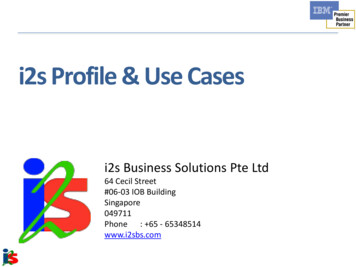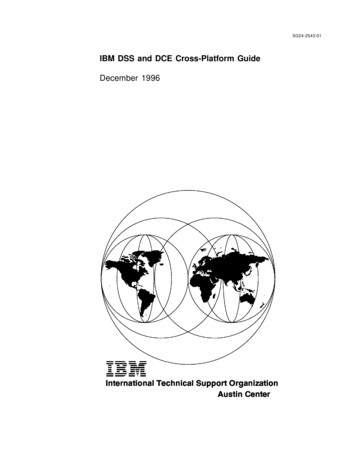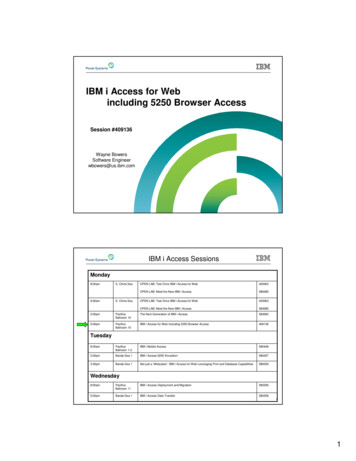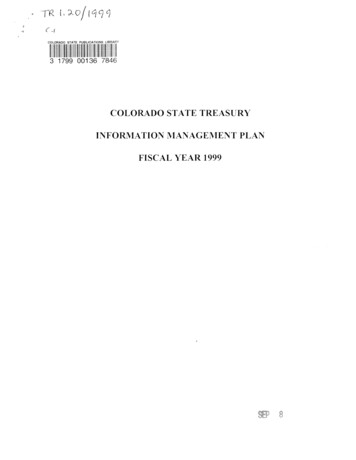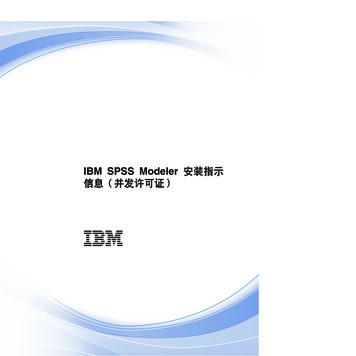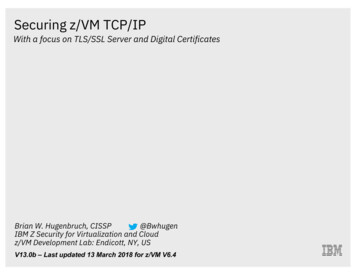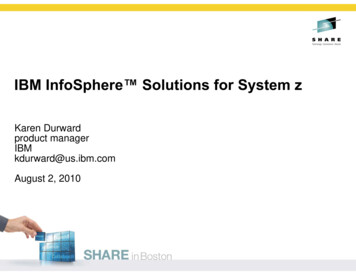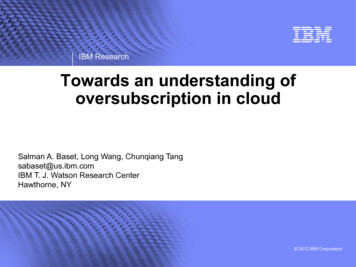
Transcription
IBM ResearchTowards an understanding ofoversubscription in cloudSalman A. Baset, Long Wang, Chunqiang Tangsabaset@us.ibm.comIBM T. J. Watson Research CenterHawthorne, NY 2012 IBM Corporation
Outline§ Oversubscription background- Airlines and cloud- What are typical overload symptoms for CPU, memory, disk, and network?- Isn’t managing oversubscribed cloud the same as ‘regular cloud’?§ Mitigating overload: mechanism vs. policy§ Contributions- Theoretical basis for oversubscription problem- A Markov model for oversubscription- SLAs and oversubscription- Results on increasing oversubscription in cloud by terminating or livemigrating a VM while meeting SLAs§ Ongoing work2 2012 IBM Corporation
Motivation10 seat capacityPlans changedlast minuteAirline boss: myplanes are not flyingfull. Overbook theseats! 2012 IBM Corporation
Motivation10 seat capacity12 people book seats, 2 cancel.Airplane flies full 2012 IBM Corporation
Motivation10 seat capacity12 people book seats, 12 show upPROBLEM!!!!!!!Refund, vouchers etc 2012 IBM Corporation
Cloud motivation§ Studies indicate that VMs do not fully utilize the provisioned resources§ Definitions- Provisioned resources§ e.g., the resources with which a VM is configured. EC2 small instance (1.7 GBmemory, 160 GB disk)- Used resources§ e.g., the resources used by a VM at a point time (1 GB memory, 50 GB disk)- Overcommitted, oversubscribed§ Can we oversubscribe the resources of a physical machine while meetingthe SLAs promised to a customer? 2012 IBM Corporation
‘Regular’ cloud8 GB RAM1 TB diskQuad core Xeon8 GB RAM1 TB diskQuad core XeonVM:2 GB RAM500 GB1 CPU4 VMs per physical machineBlack box indicates provisioned resources per VM 2012 IBM Corporation
Oversubscribed cloud8 GB RAM1 TB diskQuad core Xeon8 GB RAM1 TB diskQuad core XeonVM:2 GB RAM500 GB1 CPU8 VMs per physical machineBlack box indicates provisioned resources per VM 2012 IBM Corporation
Oversubscribed cloud8 GB RAM1 TB diskQuad core Xeon8 GB RAM1 TB diskQuad core XeonVM:2 GB RAM500 GB1 CPU8 VMs per physical machineBlack box indicates provisioned resources per VMGreen box indicates used resources per VM 2012 IBM Corporation
Overload!8 GB RAM1 TB diskQuad core Xeon8 GB RAM1 TB diskQuad core XeonVM:2 GB RAM500 GB1 CPUVMs requesting morememory than availablein physical server.8 VMs per physical machineBlack box indicates provisioned resources per VMGreen box indicates used resources per VM 2012 IBM Corporation
What are overload symptoms for CPU, memory, network, disk?§ CPU§ Memory§ Disk§ Network 2012 IBM Corporation
What are overload symptoms for CPU, memory, network, disk?§ CPU- less CPU share per VM, long run queues§ MemoryAre symptomsrelated?- Swapping to hypervisor disk, thrashing§ Disk (spinning)- Increased r/w latency, decreased throughput§ Network- Link fully utilized 2012 IBM Corporation
What are overload symptoms for CPU, memory, network, disk?§ CPU- less CPU share per VM, long run queues§ Memory- Swapping to hypervisor disk, thrashingLocallyattacheddisksNetwork attacheddisks§ Disk (spinning)- Increased r/w latency, decreased throughputIncreased disktraffic§ Network- Link fully utilizedIncreasednetworktraffic 2012 IBM Corporation
What are overload symptoms for CPU, memory, network, disk?§ CPU- less CPU share per VMMonitoring agents within VMs andhypervisor may not get a chance torun as per their schedule§ Memory- Swapping to hypervisor disk, thrashing§ Disk (spinning)- Increased r/w latency, decreased throughput§ Network- Link fully utilized 2012 IBM Corporation
What are overload symptoms for CPU, memory, network, disk?§ CPU- less CPU share per VM§ Memory- Swapping to hypervisor disk, thrashing§ Disk (spinning)- Increased r/w latency, decreased throughput§ Network- Link fully utilizedIf work of all VMs is I/O bound, a fullyutilized link (for one VM) may causeother VMs to sit idle, wasting CPUand memory resources. 2012 IBM Corporation
Isn’t managing oversubscribed cloud the same as ‘regular’ cloud?§ Regular cloud- Only network and disk are susceptible to overload- CPU and memory are never oversubscribed§ Oversubscribed cloud- CPU, disk, memory, and network are oversubscribed 2012 IBM Corporation
Mitigating overload§ Mechanism vs. policy§ Mechanisms- Stealing§ Borrow resources from one VM and give it to other- Quiescing§ Terminate a VM. Which VMs to terminate?- Migrate§ Live migration- Shared vs. local disk storage- VMware VMotion- Streaming disks§ Offline migration§ Which VMs to live / offline migrate?- Network memory§ Swap space is over network. May work for transient workloads. 2012 IBM Corporation
Handling overload§ Overload detection- Detect that overload is occurring (within VMs or physical server)- Hard or adaptive thresholds§ Overload mitigation- Mitigate overload by terminating a VM, live migrating it, or using networkmemory§ It is hard! 2012 IBM Corporation
Overload mitigation policy§ Factors to consider- Performance- Useful work done- Cost- Fairness- Minimal impact to VMs- SLAs§ An optimization problem 2012 IBM Corporation
Oversubscription and classical problems§ Multiple-constraints single knapsack (FPTAS polynomial in n and 1/e for e 0)-Given n items and one bin (single knapsack)-Each item and bin has d dimensions, and each item has profit p(i)-Find a packing of n items into this bin which maximizes profit, while meeting binsdimensions§ Multiple knapsacks (bin packing) (PTAS polynomial in 1/e for e 0)-Given n items, and m bins (knapsacks)-Each item has a profit, p(i), and size(i)-Find items with maximum profit that fit in n bins§ Vector bin packing (no-APTAS cannot find a PTAS for every constant e 0)-Given n items and m bins-Each item and bin has d dimensions-Find a packing of n into m which minimizes m, while meeting bins dimensions§ Online vector bin packing-Same as above-but also minimize the total number of moves across bins or VM terminations 2012 IBM Corporation
The underlying theoretical problem of oversubscription§ Online multiple constraints multiple knapsack problem with costs of moving betweenknapsacks-Given n items (VMs), and m bins (servers)Each VM and server has d dimensions, and each VM has utility u(i)Moving a VM from server i to j has a cost MijTerminating a VM k has a cost Tklambda is the rate of arrival of workloads within VMs (iid)Utility of a VM and PM, UVM, UPM, respectivelyState space:§ resource consumption of PMs and VMs resources- PM resources: CPU, memory, disk, network- state tuple: (PMi – CPU , PMi – disk , PMi – mem, PMi – network )- state space explosion§ probability of being in that state, given workload distributions§ Utility of a state§ Given workload distributions, find argmax number of VMs s.t.-Total utility (profit) is maximized 2012 IBM Corporation
SLAs and overload§ Overload must be precisely defined as part of SLAs§ What are the SLAs of public cloud providers?22-None provide any performance guarantees for compute-Uptime guarantees, typically only for data center and not for VMs. 2012 IBM Corporation
Compute SLA comparisonAmazon EC2Azure ComputeRackspace CloudServersTerremark vCloudExpressStorm on DemandService guaranteeAvailability (99.95%)5 minute intervalRole uptime andavailability, 5 GranularityData centerAggregate across allrolePer instance and datacenter mgmt. stackData center management stackPer instanceScheduledmaintenanceUnclear if excludedInclud. in serviceguarantee calc.ExcludedUnclear if excludedExcludedPatchingN/AExcludedExcluded if managedN/AExcludedGuarantee timeperiod365 days or since lastclaimPer monthPer monthPer monthUnclearService credit10% if 99.95%Violation merReporting timeperiodN/A5 days of occurrenceN/AN/AN/AClaim filing timerperiod30 business days oflast reported incidentin claimWithin 1 billing monthof incidentWithin 30 days ofdowntimeWithin 30 days of thelast reported incidentin claimWithin 5 days ofincident in questionCredit only forfuture paymentsYesNoNoYesNo10% if 99.95%to 100% 1 for 15 minuteUptime guaranteeson a5%datacenter (veryweak)25% if 99%downtime up to 50% ofImplicit uptime guarantees on a customerVM bill1000% for everyhour of downtime –Cloud SLAs: Present and Future. To appear in ACM Operating System Review 2012 IBM Corporation
Questions investigated in this paper§ Overload detection interval and request inter-arrival within VM§ Mitigating overload by terminating VMs over a do nothing approach§ Mitigating overload by live migrating a VM, over terminating VMs and do nothing.§ Simulations-Setup-§ 40 PMs (rack of physical machines), each has 64 GB of RAM§ Only memory overload§ 30 days of simulated time§ Number of VMs fixed§ Request interarrival rate exponentially distributed§ Request size exponential and pareto – (real data set in progress)§ Live migration: 1 VM per minute at most (mig-1) or all VMs until overload alleviated (mig-all).Overload definition§ If memory consumption exceeds 95% of physical server memory for five contiguous minutes,overload occurs.-Metrics§ Percentage of VMs not experiencing overload for given workload arrival rate§ Number of VMs terminated and migrated24 2012 IBM Corporation
Max. # VM killedquiesceno quiesce50032.53537.54042.54547.550uptime 5010015migs / min% of VMs killeduptime 99.9%Preliminary results5010§ Overcommit factor is 2.0 All VMs have same provisioned memory, i.e., 2 GB. 5§ 32.5Physical server has 64 GB memory.3537.54042.54547.5500§ 200 Average load on VMs as a function of provisioned capacity.E.g., 32.5% of 2 GB 650 MB32.53537.54042.54547.550§ When average load on all VMs is 50% of provisionedcapacity,physicalservermemoryis exhausted.Loadon VMs asthea functionof theirprovsionedcapacity.Overcommit factor is100§ Migration strategy: Select the VM with the largest memory consumption and terminate or live migrate heirprovisionedcapacity.Overcommitfactoris 2.§ Insights:25-Terminating a VM improves the uptime performance of all VMs by more than a factor of 2 overa do nothing approach.-Mig-1 (at most one migration per minute results in a step function like reduction in uptime) 2012 IBM Corporation
Max. # VM killeduptime 99.9%100quiesceno quiesce50032.535Percentage37.540of VMs42.5 45Percentage of VMs migrated47.55015100migs / min% of VMs killeduptime 99.9%Preliminary -1032.53537.54042.54547.550Load on VMs as a function of their provsioned capacity. Overcommit factor is 2§ Insights:100-One or more VMs killed as aggregate memory consumption of all VMs approach physicalserver memory032.53537.54042.54547.550Load on VMs as a function of their provisioned capacity. Overcommit factor is 2.26-mig-all can overly stress the network-Always selecting the VM with highest memory consumption for terminating or live migratingis not a good idea! 2012 IBM Corporation
Questions under investigation§ To what extent a combination of VM quiescing and live migration schemes perform better than theindividual schemes?§ Does asymmetry in oversubscription levels across PMs (within the same rack) and workload distributionslead to a higher overall overcommit level?§ When identical or asymmetric capacity VMs have different SLAs, which overload mitigation scheme givesthe best results?§ When the available SLAs are defined per VM group instead of per VM, can it be leveraged to improve theperformance of underlying overload mitigation scheme?§ How are the results affected when other resources such as CPU, network, and disk are oversubscribed?§ What is the best strategy for selecting VMs to terminate or live migrate?§ How the SLAs should be defined for oversubscribed environments?§ How can we answer all of the above questions for real workloads in a test-bed or deployed environment?27 2012 IBM Corporation
All VMs have same provisioned memory, i.e., 2 GB. Physical server has 64 GB memory. ! Average load on VMs as a function of provisioned capacity. E.g., 32.5% of 2 GB 650 MB ! When average load on all VMs is 50% of provisioned capacity, the physical server memory is exhausted.





